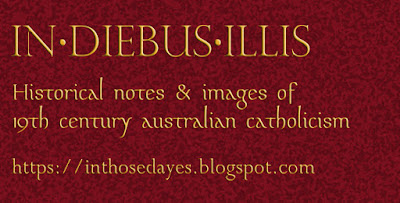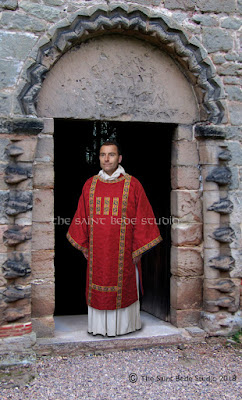Every now and then, articles will appear on Blogdom discussing that
mutual enrichment between the Ordinary and Extraordinary forms of the Roman Rite which Pope Benedict advocated in his motu proprio
Summorum Pontificum.
Perhaps the Saint Bede Studio may be allowed its two-pence worth about this subject? In this post, let us discuss this from the perspective of mutually enriching the
aesthetics of the two Forms for, although the external appearances are of a lesser degree of importance than the prayers and rituals of the Mass, these external forms do, nevertheless, make a strong impression upon those who look at them, namely the
congregation.
For the purposes of this discussion, let us consider the scenario where both Forms of the Roman Rite are offered in the same Church or Parish, using the same sanctuary or altar and by the same priest and community.
 |
The Benedictine Abbey of Le Barroux:
Contemporary vestments intended for the EF. |
Whilst it is true that there are in use worldwide tasteful vestments and tasteless vestments, there is no stipulation that a particular
style of vestments is appropriate to one Form of the Roman Rite more than another. Readers of liturgical blogs might be excused for thinking this is not the case: they might be forgiven for thinking that the only appropriate style of vestments for the Extraordinary Form is the Baroque chasuble (sometimes mistakenly referred to as the "Roman" chasuble, or, more derisively, the
fiddleback). They might be forgiven this, because every day we see photographs appear on numerous Blogs of celebrations of the Extraordinary Form with Baroque vestments. Sometimes, we even see Extraordinary Form Masses being celebrated with
brand new Baroque vestments. Well, the equation of Baroque vestments with Catholic Tradition simply is a
non-sequitur.
When the approach is taken that Baroque vestments must be used for the Extraordinary Form, we risk moving away from Tradition into the Re-Creation of bygone eras. Tradition isn't about that, nor is the Hermeneutic of Continuity, which we hear so much about these days. This is a very shallow interpretation of Tradition and Continuity. Read more about that
here.
In short, one obvious sort of mutual enrichment of the two Forms of the Roman Rite is when people observe that the same styles of vestments are appropriate for both and there is no required disjunct between the two.
Another is the manner in which altars are set up. Leaving aside the question of the Orientation of the Extraordinary Form, an altar may be set up for Low Mass in the Extraordinary Form simply with two candlesticks and a Crucifix, resting on the mensa of the altar. Tragically, some have now implemented the practice that, for the celebration of the Extraordinary Form, a timber shelf is placed on an altar, sometimes with a faux-tabernacle built into it, in order to make the altar seem more like "a Traditional High altar". This frightful practice is not only nonsense, it is also unliturgical. Is it not disrespectful of the dignity of a consecrated altar to place portable shelves on it?
 |
| Processional Cross as the altar Cross. |
Vest the altar in worthy antependia (altar frontals) and with cloths of white linen. If you find altar cloths (the cloths that cover the mensa of the altar) in your church which are made in the liturgical colours (another frightful practice) instead of pure white, dispose of these with a just penalty.
You don't have to place six candlesticks on your altar for the Ordinary or Extraordinary Form. It became fashionable to do this, adopting what people referred to as the
Benedictine Arrangement. Two good-sized, worthy candlesticks will do, particularly if the altar is a small one. If you do use a set of six candlesticks, make sure they are a matching set and proportionate to the altar.
Here is another suggestion: if you have a free-standing altar, locate the Processional Cross in the very centre of the altar (at the front of the altar for the Ordinary Form and at the back of the altar for the Extraordinary Form). Anciently, the Processional Cross was used this way before there was ever a thought of placing a Cross on the altar. A processional Cross so located can serve for both the Extraordinary and Ordinary Forms.
Secondly, then, ornament the altar for both Forms of the Roman Rite in much the same manner, even if the Orientation of the celebration is different.
 |
| Priestly crossing of the stole. |
Thirdly, for priest readers:
start crossing your stole when you vest for Mass in the Ordinary Form. It might be immediately objected that this is forbidden by the GIRM (a debatable point), but if you crossed your stole, would anyone mind that much? If they do, they don't have enough to do with their time. It is an ancient practice to cross the stole and it reinforces the distinction between the threefold Orders of deacon, priest and bishop. Give it a try.




















.jpg)































